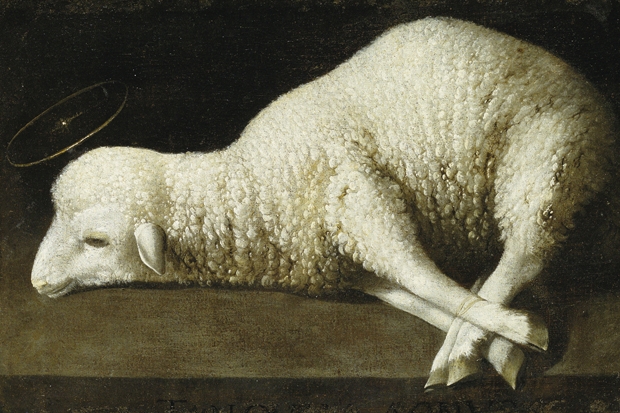It seems suitable that just round the corner from the Zurbarán exhibition at the Palais des Beaux Arts is the Musée Magritte. Surrealism was in the air of 20th-century Belgium, just as much as it was in the atmosphere of Spain. And of course in many cases its leading figures — Buñuel, Dalí, René Magritte — were lapsed Catholics. Francisco de Zurbarán (1598–1664), in contrast, was one of the most striking examples in art history of the unlapsed Catholic. His paintings express the faith of the Spanish counter-reformation at full strength, but the results are often as disconcerting in their way as a painting of baguettes raining down from the sky.
In Zurbarán’s world, however, there are more likely to be showers of roses than of bread. Pink and white blooms have obviously just fluttered down on St Francis in the ‘Miracle of Portiuncula’ (c.1630–1). They are carefully arranged at regular intervals on the steps around Francis, who raises his eyes to the vision above in which Christ and the Virgin have appeared to present him with an indulgence.
As is usually the case with Zurbarán, it’s not the sacred beings occupying the golden clouds above who seem wonderful and strange, it’s the saint with his heavy habit and wrinkled brow, and those roses so carefully arranged around him. In other words, it was Zurbarán’s meticulous depiction of the natural that gives his pictures such bizarre punch.
Art historically, Zurbarán belongs to the aftermath of Caravaggio, whose influence rapidly flooded Europe in the early 17th century. The Italian painter used what David Hockney has called ‘Hollywood lighting’ — deep shadows, spot-lit highlights — to give unprecedented drama, realism and emotional impact to religious art. Zurbarán used the same devices to make the most ordinary objects — a vase, a piece of cloth — appear supernatural.








Comments
Join the debate for just £1 a month
Be part of the conversation with other Spectator readers by getting your first three months for £3.
UNLOCK ACCESS Just £1 a monthAlready a subscriber? Log in